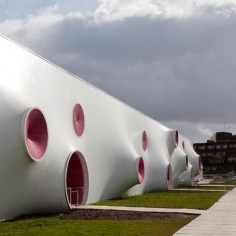MAGMA ARCHITECTURE
LONDON 2012 OLYMPIC GAMES

source: vasinet
Магма (Magma) была сконструирована в 2003 архитектором Мартином Остерманом и дизайнером Леной Кляйнхенц (Martin Ostermann, Lena Kleinheinz). Выставка известна своей инновационностью, смелым и оригинальным подходом в архитектуре.
Основную часть композиции составляет оранжевый гибкий материал (соединение эластана и полиамида) протянутый между стенами, потолком и полом. Ткань является видимой частью выставки, но все же она является инструментом, с помощью которого зрители могут сосредоточиться на нужных деталях. Посетители наклоняются под оранжевым материалом и просовывают голову в специальные отверстия, через которые и рассматривают экспонаты, подвешенные на проводах.
.
.
.
.
.
.
.
source: thecoolhunter
Berlin’s Magma Architecture won several awards for its entry in the JETZT | NOW series of temporary INSTALLATIONS at the Berlinische Galerie, Museum for Contemporary Art, Photography and Architecture. Magma’s INSTALLATION, 11th in the series, was called fittingly “head-in | im kopf” and its concept is based on exploring the properties of materials, form, color and light.
The main feature of the installation is an alarmingly orange flexible fabric (polyamide-elastan mix) stretched between the walls, ceiling and floor. The fabric is the most visible part of the exhibit, yet it is also the tool with which the viewers can focus on smaller details.
Visitors bend down under the fabric into which openings were cut. Through these holes, visitors pop their heads up into the orange space to view drawings, models and photographs suspended from wires. These items are from Magma’s work and include representations of the revitalization of the former GDR Radio Centre (Berlin, Nalepastrasse, 2007), a bridge over the Landwehrkanal river in Berlin (competition entry in 2006), the new Nexus Productions headquarters in London, and the exhibition Trial & Error in London (2003). Luckily, we have images to show how it all worked as the full effect of the experience is quite impossible to describe in mere words.
The project team for head-in | im kopf included Anke Noske, Hendrik Bohle, Dominik Jörg, Lena Kleinheine, Ksenia Kagler, Yohko Mizushima, Lena Kleinheinz, Martin Ostermann and Ben Reynolds.
.
.
.
.
.
.
.
source: dezeen
Berlin practice Magma Architecture have created an INSTALLATION called Head-in for a solo exhibition of their work at Berlinische Galerie in Berlin, Germany.
The structure is supported above the floor and made from fabric stretched between aluminium frames on the walls and ceiling of the gallery.
Visitors view models of the practice’s projects – which are suspended inside the void – by standing underneath and inserting their heads through holes in the underside of the structure.
magma architecture is specialised in creating spaces and buildings in complex geometrical shapes. The unusualness of these spaces triggers the spectator’s curiosity and enhances them to appropriate and experience them in unexpected ways. Models of magma architecture’s spaces only insufficiently create the full, physical experience. The aim of the exhibition design was to display not only architectural models as usually on show in exhibitions, but also integrate a 1:1 piece of the characteristic spaces created by magma architecture.
The centrepiece of the exceptional spatial INSTALLATION for the Berlinische Galerie is an amorphous spatial sculpture custom tailored for the 150 m² temporary exhibition space. It is constructed of fabric (spandex) which spans between the four walls and ceiling of the exhibition space pending above the floor. Aluminium frames are used to fix the fabric to walls and ceiling.
Visitors of the exhibition can poke their heads through the fabric evolving surrounded by the organic space and vivid colour of the INSTALLATION.
Inside the suspended room models, drawings and photographs are displayed, amongst others the designs for the revitalisation of the former GDR Radio Center in Berlin, the new Nexus Productions headquarters in London and the pPod mobile theatre. Through carefully orchestrated geometries the space is transformed into a vibrant and dynamic environment revealing a spatial phenomenon not normally achieved in architecture or interior design. The spatial INSTALLATION appears almost alienated from its surrounds of the Berlinische Galerie yet remains fixed to and ultimately enveloping it to spawn a relationship of dynamism and contrast.
The interior has been programmed strategically with works to enable the inhabitant to physically immerse themselves in this realm. The production of sensually inspiring spaces and uses and a playful dealing with programmes, functions, materials and geometries practised by the office is mirrored in the exhibition architecture.
magma architecture was founded in 2003 by Martin Ostermann and Lena Kleinheinz in Berlin. Martin Ostermann was previously a senior architect at Studio Daniel Libeskind, Lena Kleinheinz is an exhibition designer specialised in interactive mediation of content.
im Kopf was rewarded an honourable mention from the AR Awards in London and a contractworld award 2008. The jury of the contractworld award 2008 noted: “The project impressed the jury with its remarkable conceptual continuity. Continuity in the sense of the spatial representation of the position from which the designers started. This tautological dimension is experienced by the observer through his physical senses, so that the exhibition leaves an enduring impression.”
.
.
.
.
.
.
.
source: magmaarchitecture
In der Ausstellungsreihe jetzt I now der Berlinischen Galerie, Landesmuseum für moderne Kunst, Fotografie und Architektur wird magma architecture zu einer Einzelpräsentation eingeladen. Als Ausstellungsinszenierung entwirft das Büro für den 150 m² großen Sonderausstellungsraum eine amorphe Raumskulptur aus einem semitransparenten Spezialgewebe bestehend aus Polyamid und Elastan. Ein vorgefertigter Schlauch spannt sich zwischen den vier Wänden und der Decke. Innerhalb dieses raumbildenden Elements werden in einem multimedialen Arrangement Arbeiten von magma architecture ausgestellt. Die Besucher eignnen sich das Innenleben aktiv an: Sie begeben sich unter die Raumskulptur und strecken den Oberkörper durch die kreisförmigen Perforierungen der Hülle. Eingehüllt in die kräftig orangefarbene Form der Hülle erleben sie eine ungewohnt fließende Raumwahrnehmung. Der materialgerechte Einsatz des dehnbaren Textils erlaubt eine maximale Raumwirkung mit minimalem Aufwand.

